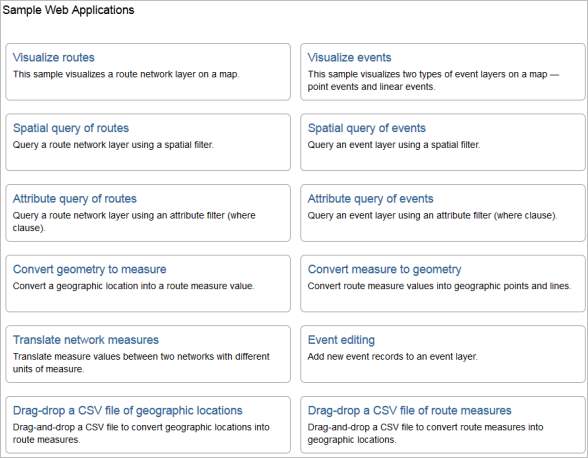Available with Location Referencing license.
ArcGIS Pipeline Referencing is an ArcGIS Server extension that provides the capability to publish LRS Networks and registered event layers as a map service.
As a map service, linear referenced data can be shared to an ArcGIS Enterprise deployment and published to your organizational account on ArcGIS Online.
Networks and events can be accessed by any client app that can consume an ArcGIS Server map service, including existing web and mobile clients. Additionally, web developers can use the Web APIs to develop web and connected mobile apps for their linear referenced data.
Pipeline Referencing enablement
The stand-alone Location Referencing installer is no longer required for 10.9 or later releases. However, you must authorize the software by entering a Location Referencing license key on each machine.
Note:
The Advanced Editing user type extension is not needed to license Location Referencing or publish and consume services enabled for Linear Referencing and Version Management.
You must have a full base Enterprise deployment and install compatible versions.
Software authorization
Obtain authorization through My Esri using email, fax, phone, or mail. Authorize Pipeline Referencing (enabled by a Location Referencing license) using your license key.
Once the ArcGIS Location Referencing license is used to authorize each instance of ArcGIS Server, the Pipeline Referencing features and services that are native to ArcGIS Enterprise are available.
Compatibility with ArcGIS Pro
ArcGIS Pro and ArcGIS Enterprise must be installed with compatible versions:
| ArcGIS Pro version | ArcGIS Enterprise version |
|---|---|
3.4 | 11.4 |
3.3 | 11.3 |
3.2 | 11.2 |
3.1 | 11.1 |
3.0 | 11.0 |
2.9 | 10.9.1 |
2.8 | 10.9 |
2.6 | 10.8.1 |
2.5 | 10.8 |
Linear Referencing capability in map services
Pipeline Referencing extends an existing map service with an additional REST service capability for linear referencing when a map is published with the Linear Referencing capability enabled.
Map services with the Linear Referencing capability enabled support the following:
- Provide LRS-based network and event layer information.
- Translate coordinate locations to routes and measures.
- Translate (locate) routes and measures to coordinates or polylines.
- Validate route and measure values.
- Convert measures between linear referencing methods (LRMs).
- Multilayer, transactional event editing, with support for overlap retirement and coincident event merging.
Pipeline Referencing provides online developer help for the REST services made available by the Linear Referencing capability.
Learn more about the Linear Referencing Service REST API and enabling the Linear Referencing capability.
Included JavaScript web developer samples
Pipeline Referencing includes ArcGIS Pipeline Referencing sample web apps that demonstrate the use of available REST services.

These developer samples demonstrate how a web or connected mobile developer can accomplish the following:
- Visualize networks on a map.
- Visualize events on a map.
- Locate measures on a route.
- Perform spatial and attribute queries for routes.
- Perform spatial, measure, and attribute queries for events.
- Convert routes and measures to coordinates.
- Convert coordinates to routes and measures.
- Convert measures between LRMs.
Web-based event data editing
ArcGIS Experience Builder is available through ArcGIS Enterprise and supports the editing of event data in a web browser using Location Referencing widgets.

Learn more about using Experience Builder and deploying Location Referencing widgets
Platform for reporting
Pipeline Referencing spatially enables event data from non-GIS systems and integrates it through the LRS. Pipeline Referencing, together with ArcGIS, can be used to produce data products and maps to support reporting on length calculations of pipeline characteristics, safety analysis, and other analyses of pipeline data. These reports and data products can provide business units within your organization transparency into many facets of pipeline data, such as pipeline assets, incidents, inspections, and pipe characteristics.